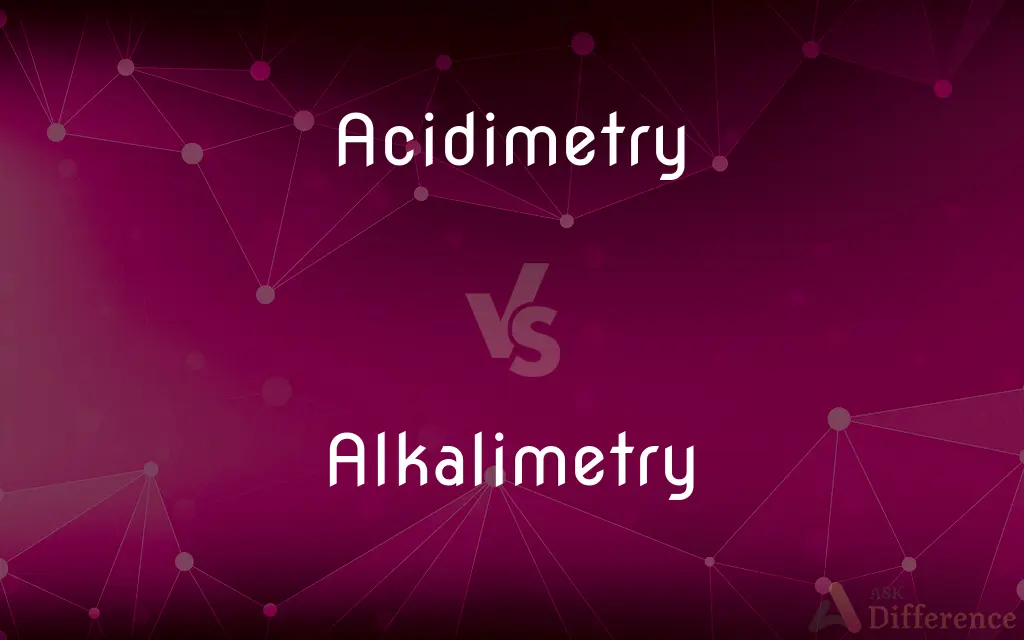Acidimetry vs. Alkalimetry — What's the Difference?
Edited by Tayyaba Rehman — By Fiza Rafique — Updated on September 30, 2023
Acidimetry is the quantification of acids in a solution using titration, while alkalimetry measures the concentration of alkaline substances. Both are analytical methods, but they focus on opposite ends of the pH spectrum.

Difference Between Acidimetry and Alkalimetry
Table of Contents
ADVERTISEMENT
Key Differences
Within the domain of analytical chemistry, the terms acidimetry and alkalimetry play significant roles. Acidimetry refers to the procedure where the concentration or strength of an acid in a given solution is determined. On the flip side, alkalimetry involves the evaluation of alkaline (or basic) substances in a sample.
Both acidimetry and alkalimetry hinge on the principle of titration. In acidimetry, a known concentration of a base is typically used to titrate an unknown acid until a neutralization point or endpoint is reached. Conversely, alkalimetry employs a known acid solution to titrate an unknown base to its endpoint.
Indicators, which are substances that change color depending on the pH, are pivotal in both acidimetry and alkalimetry. When conducting acidimetry, the solution will typically turn from acidic to neutral, signaling the endpoint. For alkalimetry, the transition is from basic to neutral, marked by a distinct color change.
While both acidimetry and alkalimetry are integral in various industries, their applications can differ. Acidimetry can be crucial in analyzing the acidity of rainwater, wines, or certain pharmaceutical products. Alkalimetry, however, might be more relevant in determining the alkalinity of waters, cleaning agents, or certain food items.
To summarize, acidimetry and alkalimetry, though opposite in their focus on acids and bases, are both rooted in the same scientific principles. Both processes leverage titration and indicators to yield precise and invaluable analytical data.
ADVERTISEMENT
Comparison Chart
Definition
Measurement of acid concentration
Measurement of alkaline concentration
Titration Process
Uses a known base to titrate an unknown acid
Uses a known acid to titrate an unknown base
Endpoint Transition
From acidic to neutral
From basic to neutral
Common Indicators
Phenolphthalein, methyl orange
Bromothymol blue, phenolphthalein
Typical Applications
Analyzing acidity in wines, rainwater
Determining alkalinity in waters, cleaning agents
Compare with Definitions
Acidimetry
Quantitative technique to assess acid content.
Acidimetry is a staple in many chemistry labs to analyze acidic solutions.
Alkalimetry
Analytical quantification of alkaline substances.
Alkalimetry is employed to determine the basicity of baking soda.
Acidimetry
Process of assessing acid strength via neutralization.
With acidimetry, we can determine how strong the given acid is.
Alkalimetry
Method to gauge basicity via reaction with acids.
Alkalimetry uses known acids to assess unknown bases.
Acidimetry
The analytical measurement of acid concentration.
Scientists use acidimetry to gauge the acidity level in orange juice.
Alkalimetry
Technique to quantitatively analyze alkaline content.
In industries, alkalimetry assists in evaluating the basic content in products.
Acidimetry
Titration method to quantify acidic substances.
Acidimetry revealed the precise acid content in the sample.
Alkalimetry
Titration procedure for measuring basic solutions.
Through alkalimetry, the basic strength of the cleaner was determined.
Acidimetry
A method of finding acidity through a base's reaction.
Acidimetry uses bases to evaluate the acid's concentration.
Alkalimetry
Process to assess alkaline strength using an acid.
Alkalimetry offers an insight into how alkaline the substance is.
Acidimetry
A hydrometer used to determine the specific gravity of acid solutions.
Alkalimetry
An apparatus for measuring alkalinity.
Acidimetry
(chemistry) The measurement of the strength of acids, especially by a chemical process based on the law of chemical combinations, or the fact that, to produce a complete reaction, a certain definite weight of reagent is required.
Alkalimetry
The process of determining the strength of an alkali.
Acidimetry
The measurement of the strength of acids, especially by a chemical process based on the law of chemical combinations, or the fact that, to produce a complete reaction, a certain definite weight of reagent is required.
Alkalimetry
The art or process of ascertaining the strength of alkalies, or the quantity present in alkaline mixtures.
Acidimetry
Volumetric analysis using standard solutions of acids to measure the amount of a base present
Alkalimetry
Volumetric analysis using standard solutions of alkali to measure the amount of acid present
Common Curiosities
What does acidimetry measure?
Acidimetry measures the concentration or strength of an acid in a solution.
How is the endpoint detected in alkalimetry?
In alkalimetry, the endpoint is usually detected using pH indicators that change color.
Do both acidimetry and alkalimetry utilize titration?
Yes, both methods are based on the principle of titration.
In what scenario is alkalimetry used?
Alkalimetry is used to determine the concentration of alkaline substances in a sample.
Can acidimetry determine the acidity of beverages?
Yes, it can analyze the acidic content in beverages like wine.
Do acidimetry and alkalimetry always give exact results?
While precise, results may vary based on equipment, technique, and sample purity.
Can both methods be applied in pharmaceuticals?
Yes, both can be crucial in ensuring drug composition and strength.
Can acidimetry be used to analyze rainwater?
Yes, acidimetry can determine the acidity of rainwater.
Why is alkalimetry vital for cleaning agents?
Alkalimetry helps determine the basic strength, ensuring the product's efficacy.
Are the indicators the same for acidimetry and alkalimetry?
Some overlap, but specific indicators may be preferred for each method.
Which known solution is used in acidimetry?
In acidimetry, a known concentration of a base is used for titration.
Can you use acidimetry for strong acids?
Yes, but caution and appropriate indicators are needed for accurate results.
Do both methods require expertise?
Proper training is advised for both acidimetry and alkalimetry to ensure safety and accuracy.
Which is more prevalent in industries, acidimetry or alkalimetry?
Both are widely used, depending on the industry's focus.
Is alkalimetry relevant in food analysis?
Absolutely, especially in foods that might have basic properties.
Share Your Discovery

Previous Comparison
Fluoridation vs. Defluoridation
Next Comparison
Skydiving vs. ParaglidingAuthor Spotlight
Written by
Fiza RafiqueFiza Rafique is a skilled content writer at AskDifference.com, where she meticulously refines and enhances written pieces. Drawing from her vast editorial expertise, Fiza ensures clarity, accuracy, and precision in every article. Passionate about language, she continually seeks to elevate the quality of content for readers worldwide.
Edited by
Tayyaba RehmanTayyaba Rehman is a distinguished writer, currently serving as a primary contributor to askdifference.com. As a researcher in semantics and etymology, Tayyaba's passion for the complexity of languages and their distinctions has found a perfect home on the platform. Tayyaba delves into the intricacies of language, distinguishing between commonly confused words and phrases, thereby providing clarity for readers worldwide.
















































